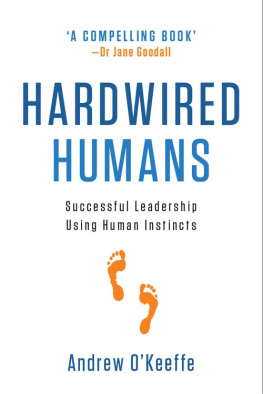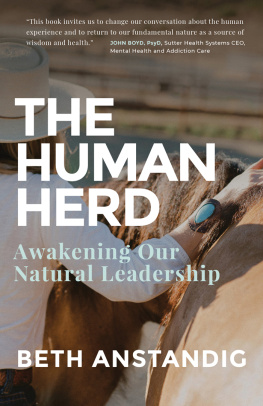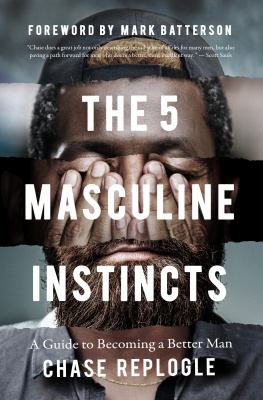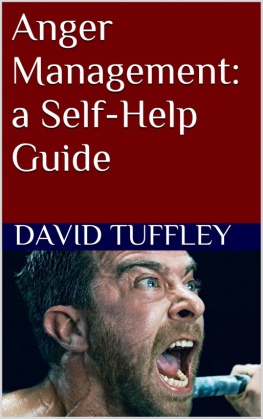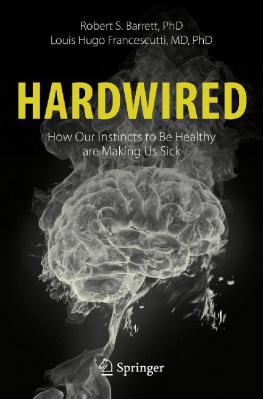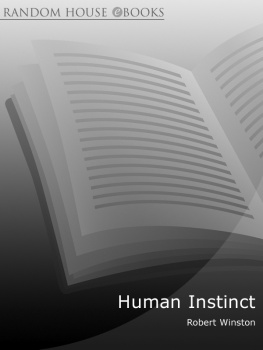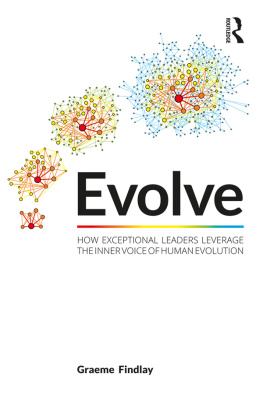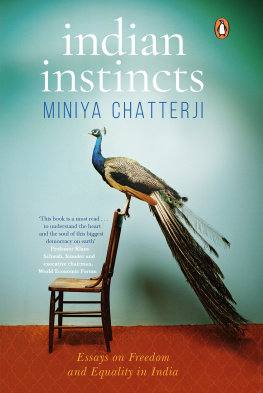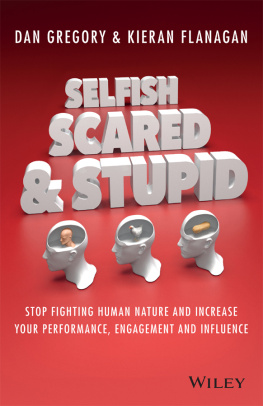Acknowledgments
I am indebted to many people for their support in the journey leading to this book.
I owe special thanks to Professor Nigel Nicholson, who years ago triggered my interest in the significance of human instincts for explaining and solving people challenges in the workplace. In 1998 I was pondering the pattern of people-related issues that occurred persistently in organisations I had worked for, and for which I didnt have a satisfactory explanation. Then I read Professor Nicholsons Harvard Business Review article and his book. It was an Ah hah! moment. Suddenly so much made sense, and in the HR teams I was with at the time we began to apply our interpretation of Nigels work. We designed a performance appraisal system that managers and staff loved. We implemented restructures smoothly and completed mergers and acquisitions with minimal disruption to services and with high staff engagement and retention. Years later I met Nigel and he has been a generous supporter and encourager of my work.
The HR teams I have worked with were instrumental in the development of my thinking and with the ways we first applied human instincts theory: teams at IBM Global Services (which just predated the crystallisation of the implications of human nature for leadership but demonstrated our instincts were correct), Cable & Wireless Optus and Sinclair Knight Merz.
Polly Cevallos of the Jane Goodall Institute of Australia holds a special place in this journey. When we take clients to zoos to learn and apply human instincts, Polly leads the discussion on chimpanzee behaviours, with the support of the wonderful zoo keepers who share their knowledge and experiences. Its a joy to work with someone with Pollys positive outlook, motivation and generosity. Thanks to Dr Jane Goodall who first inspired me as a kidreading in the National Geographic of her research and adventuresand then years later I heard her speak and had my second light-bulb moment when I saw the connection to our own human nature as social animals. Dr Jane is a generous supporter of my work and one of the most beautiful people you could ever hope to meet.
Thanks to the wonderful and inspiring zoo keepers who share their insights and stories with our clients. I never tire of both the stories and the jaw-drop-ping reactions of business leaders and HR professionals as they see the similarities of the apes behaviour to our own and how they are then able to apply that insight. Thanks to Louise Grossfeldt and Allan Schmidt at Taronga Zoo, Damian Lewis at Melbourne Zoo and Leif Cocks at Perth Zoo. I am very grateful to the management of Taronga Zoo for their support in sharing the stories of their chimps and for their wonderful facility, which, quite deservedly, is one of Sydneys top tourist attractions.
I founded Hardwired Humans (the company) with Cathy Wilks. We had great fun, stimulation and satisfaction in bringing the services to market and adding value to client organisations. To Cathy I extend my sincere gratitude.
We get to work with wonderful clients. The client champions are too many to mention. Ill limit the specific thanks to the clients involved in a PhD research study being conducted by Tamzyn Dorfling at Macquarie Graduate School of Management under the supervision of Professor Richard Badham: Andria Wyman-Clarke and Paul Bowles of Thales, Jo Hilyard of Philips, Kit Middleton of Symantec, Michael Murphy of Flight Centre, Nicole Sullivan of Metro Trains Melbourne and Yvonne Villinger of DB Schenker.
There is one other client person who deserves a special mention! When Cathy and I took the Hardwired Humans services to the market, the first person who signed up to our first public program was Ken Pattemore, then of Colonial First State now with Challenger. In sporting parlance, we call Ken our No. 1 ticket holder!
Many organisations have been generous in bringing the implications of instincts to the attention of their members: AGSM Executive Programs, Australian Human Resources Institute, the CEO Forum and HR Director Forum, Macquarie Graduate School of Management and Mt Eliza Executive Education.
Thanks to the energetic and professional book production team. Thanks to Jeff Higgins and his colleagues at Dennis Jones & Associates for their expertise and guidance, Deb McInnes and her team for the expert promotion campaign and the creative Sheila Parr and Matt Donnelley and their colleagues at Greenleaf Book Group for the cover design and layout. Thanks to Robert Stapelfeldt at McPhersons Printing Group and to Peter Kanellopoulos, Alex Kane and Renee Anderson at Packforce for their distribution service.
At the risk of sounding corny I thank my Mum and Dad. Among many things to be grateful for, from Mum I acquired my love of the humanities and from Dad I had the best career advice you could ever hope forwhich is worth sharing as it may help parents and leaders give career advice. At the end of high school I didnt know what I wanted to study at university. Dad never suggested what I should do and didnt even mention options. He helped me in the form of a question: Of all the work subjects I talk about at home, what do you enjoy most? Oh, that was easyindustrial relations! I always loved Dad talking about union matters and the people-related challenges he faced as Chief Engineer at Broken Hills major mine. Dads point in asking the question to help me identify what I most enjoyed was that I would be choosing a subject that stimulated my curiosity and hence I would always want to know more about.
Last, and most importantly, thanks to my wife, Jude. She is amazingly supportive of the hours I have devoted to writing this book, she encourages my passion for the subject and adds to my thinking as we bounce ideas around. Jude is the one who set the focus of this book, suggesting that it should be written as a practical guide for managers to help them with the people dimension of their role.
Also by Andrew OKeeffe
The Boss
Appendix The 9 Human Instincts Defined
| SOCIAL LIVING How Humans Live |
|---|
| Social Belonging | Humans desire strong bonds within family-sized groups of around 7 people and a sense of belonging in clans of up to 150. |
| Hierarchy and Status | Humans seek superiority or security in hierarchical systems. We seek status symbols, recognition and elevation within the hierarchy. |
| THINKING AND FEELING How Humans Think and Feel |
|---|
| Emotions Before Reason | Humans trust their emotional instincts above all else and use emotions as their first screen for all information received. We hear negative news first and loudest. |
| First Impressions to Classify | Humans quickly classify people, situations and experiences into categories (good or bad, in or out) based on first impressions and gut feelings rather than engage in time-consuming analysis. |
| Loss Aversion | Humans seek to avoid loss and risky situations but fight frantically when feeling threatened. We explore and are curious about the world around us when we feel safe. |
| Gossip | Humans seek and share information. We share information with others we like and use it to build alliances. We love to tell and hear stories. |
| Empathy and Mind Reading | Humans utilise empathy and mind reading to build relationships, be friendly and gather information. |
| Confidence Before Realism | Humans radiate confidence to move forward in the world, often denying what is realistic. We allow confidence to conquer realism to get what we want. |
| Contest and Display | Humans seek to impress others and to demonstrate their worth as a means to gain advantages. We spend inordinate amounts of time and energy making ourselves look good in various ways. |

